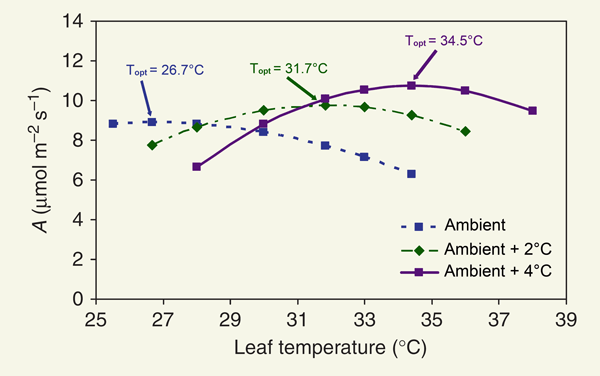Reference
Gunderson, C.A., O'Hara, K.H., Campion, C.M., Walker, A.V. and Edwards, N.T. 2010. Thermal plasticity of photosynthesis: the role of acclimation in forest responses to a warming climate. Global Change Biology 16: 2272-2286.
Background
In discussing "the long-term impacts of atmospheric warming on forest productivity and composition," the authors write that "because range boundaries often follow temperature gradients, it is inferred that species differ in temperature sensitivity, such that climatic warming would cause extensive range shifts and local extinctions." But is this really so? Noting that "without data to suggest otherwise, forest biogeography simulations use conditions in a species' current range (the climate envelope) to suggest limits for its growth and survival." Recently, however, this concept has been severely critiqued in many quarters. Hence, the researchers from the Environmental Sciences Division of the Oak Ridge National Laboratory in Tennessee (USA) set about to see if they too might possibly obtain "data to suggest otherwise."
What was done
In their approach to the subject, Gunderson et al. "investigated photosynthetic sensitivity to temperature and the potential for acclimation in relation to the climatic provenance of five species of deciduous trees, Liquidambar styraciflua [sweetgum], Quercus rubra [northern red oak], Quercus falcata [southern red oak], Betula alleghaniensis [yellow birch] and Populus grandidentata [bigtooth aspen]." This they did out-of-doors within open-top chambers that were maintained at three different temperature regimes -- ambient and ambient plus 2 and 4°C above ambient -- for a period of three years, "tracking natural temperature variability," as they describe it, which occurred throughout days, over seasons and among years.
What was learned
The five scientists report that "warming treatments resulted in a shift in the temperature response curves for CO2 assimilation, such that leaves in warmer treatments had higher temperature optima [Topt]," an example of which phenomenon is depicted in the figure below for Q. rubra seedlings during one specific month.

Figure 1. Net CO2 assimilation rate vs. leaf temperature in Quercus rubra seedlings during June of 2003 in the ambient (A) and elevated (A+2°C and A+4°C) temperature treatments.
As may be seen from this figure, the trees growing in progressively warmer environments had progressively higher Topt values; and there was a tendency for the net CO2 assimilation rates at those higher Topt values to be a bit higher as well. Gunderson et al. additionally note that this adjustment in photosynthetic response was typically accomplished over a period of as little as two days; while indicating that "others have found all or most acclimation within 2-6 days (Veres and Williams, 1984; Hill et al., 1988; Battaglia et al., 1996; Turnbull et al., 2002; Froux et al., 2004)." They also state that a similar "adjustment of thermal optima was confirmed in all species, whether temperatures varied with season or treatment, and regardless of climate in the species' range or provenance of the plant material," and they say that the observed "responses to the temperature manipulation were not different from the seasonal acclimation observed in mature indigenous trees," which they also investigated locally.
What it means
"In all species tested," in the words of the scientists who did the work, "optima shifted with air temperature, improving carbon gain during otherwise non-optimal portions of the growing season, and moderating the impact of a 2-4°C increase in temperature," and they say that "the strong acclimation potential observed in this investigation suggests that seedling physiology is not as sensitive to warming per se as predicted by original algorithms." Thus, they suggest that "photosynthetic responses should not be modeled using static temperature functions," or what many call climate envelopes, "but should incorporate an adjustment to account for acclimation," noting that "the high degree of homeostasis observed indicates that direct impacts of climatic warming on forest productivity, species survival, and range limits may be less than predicted by existing models."
In light of these several observations, it would indeed appear that earth's trees should be able to successfully adjust their physiology to accommodate a warming of the magnitude and rate-of-rise that is typically predicted by climate alarmists to accompany the projected future increase in the air's CO2 content. In fact, if the planet's trees can adjust their physiology to not only survive an instantaneous warming of 2-4°C, but to actually benefit from it, as has been demonstrated to be the case by Gunderson et al., they would probably relish the opportunity to respond to a similar warming projected to develop over a century or more. And when one factors in the aerial fertilization effect of the rising atmospheric CO2 concentration, plus its transpiration-reducing effect that boosts tree water use efficiency, as well as CO2's ability to also raise the Topt values of most plants, the world's forests are seen to possess the ideal mix of ingredients to support a tremendous "greening of the earth."
References
Battaglia, M., Beadle, C. and Loughhead, S. 1996. Photosynthetic temperature responses of Eucalyptus globulus and Eucalyptus nitens. Tree Physiology 16: 81-89.
Froux, F., Ducrey, M., Epron, D. and Dreyer, E. 2004. Seasonal variations and acclimation potential of the thermostability of photochemistry in four Mediterranean conifers. Annals of Forest Science 61: 235-236.
Hill, R.S., Read, J. and Busby, J.R. 1988. The temperature-dependence of photosynthesis of some Australian temperate rainforest trees and its biogeographical significance. Journal of Biogeography 15: 431-449.
Turnbull, M.H., Murthy, R. and Griffin, K.L. 2002. The relative impacts of daytime and nighttime warming on photosynthetic capacity in Populus deltoides. Plant, Cell and Environment 25: 1729-1737.
Veres, J.S. and Williams III, G.J. 1984. Time course of photosynthetic temperature acclimation in Carex eleocharis Bailey. Plant, Cell and Environment 7: 545-547.
Reviewed 1 September 2010



